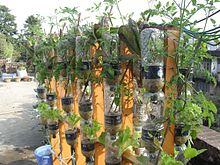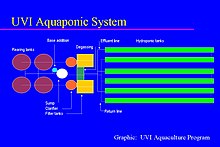In aquaculture, effluents accumulate in the water, increasing toxicity for the fish. This water is led to a hydroponic system where the by-products from the aquaculture are broken down by nitrogen fixing bacteria, then filtered out by the plants as vital nutrients, after which the cleansed water is recirculated back to the animals.
As existing hydroponic and aquaculture farming techniques form the basis for all aquaponics systems, the size, complexity, and types of foods grown in an aquaponics system can vary as much as any system found in either distinct farming discipline.[1]
History
Aquaponics has ancient roots, although there is some debate on its first occurrence:
- Aztec cultivated agricultural islands known as chinampas and are considered by some as the first form of aquaponics for agricultural use[2][3] where plants were raised on stationary (and sometime movable) islands in lake shallows and waste materials dredged from the Chinampa canals and surrounding cities are used to manually irrigate the plants.[4][5]
- South China and Thailand who cultivated and farmed rice in paddy fields in combination with fish are cited as examples of early aquaponics. These polycultural farming systems existed in many Far Eastern countries and raised fish such as the oriental loach (泥鳅, ドジョウ),[6] swamp eel (黄鳝, 田鰻), Common (鯉魚, コイ) and crucian carp (鯽魚)[7] as well as pond snails (田螺) in the paddies.[8][9]
Inspired by the successes of the New Alchemy Institute, and the reciprocating aquaponics techniques developed by Dr. Mark McMurtry et al., other institutes soon followed suit.
Starting in 1997, Dr. James Rakocy and his colleagues at the University of the Virgin Islands researched and developed the use of Deep Water Culture hydroponic grow beds in a large scale aquaponics system.[10]
The first aquaponics research in Canada was a small system added onto existing aquaculture research at a research station in Lethbridge, Alberta.
Canada saw a rise in aquaponics setups throughout the ’90s, predominantly as commercial installations raising high value crops such as trout and lettuce.
A setup based on the deep water system developed at the University of Virgin Islands was built in a greenhouse at Brooks, Alberta where Dr. Nick Savidov and colleagues researched aquaponics from a background of plant science.
The team made findings on rapid root growth in aquaponics systems, on closing the solid waste loop, and that because of certain advantages in the system over traditional aquaculture, the system can run well at a low pH level, which is favoured by plants but not fish.
The Edmonton Aquaponics Society in Northern Alberta is adapting Dr. Savidov's commercially sized system to a smaller scale prototype that can be operated by families, small groups, or restaurants. They intend to further develop the closed solid waste loop.[11]

Vegetable production part of the low-cost Backyard Aquaponics System developed at Bangladesh Agricultural University
In Bangladesh, the world's most densely populated country, most farmers use agrochemicals to enhance food production and storage life though the country lacks oversight on safe levels of chemicals in foods for human consumption.[15]
To combat this issue a team led by Professor Dr. M.A. Salam at the Department of Aquaculture of Bangladesh Agricultural University, Mymensingh has created plans for a low cost aquaponics system to provide chemical free produce and fish for people living in adverse climatic conditions such as salinity-prone southern part and flood-prone haor area in the eastern region.[16][17]
Recent years have seen a shift towards community integration of aquaponics, such as the nonprofit foundation Growing Power that offers Milwaukee youth job opportunities and training while growing food for their community.
The model has spawned several satellite projects in other cities, such as New Orleans where the Vietnamese fisherman community has suffered from the Deepwater Horizon oil spill, and in the South Bronx in New York City.[18]
In addition, aquaponic gardeners from all around the world have gathered in online community sites and forums to openly share their experiences and promote the development of this form of gardening.[19]
Source: Wikipedia.org
More to come on This and Hopefully I will have some of my own videos to show on my attempt at building a working open air Aquaponics system this year.
Somebody Come and Play Today! Earn as You Learn, Grow as You Go!
The Man Inside the Man
from
Sinbad the Sailor Man
A
JMK's Production
Share this page
TTFN
CYA Later Taters!
Thanks for stopping by.
Donnie/Sinbad the Sailor Man
P.S. Sweet Sixteen My Breakout Year's Hottest and Fastest Growing Biz Op? Do You Want In? If You Do! Click Here and Sign Up!



No comments:
Post a Comment